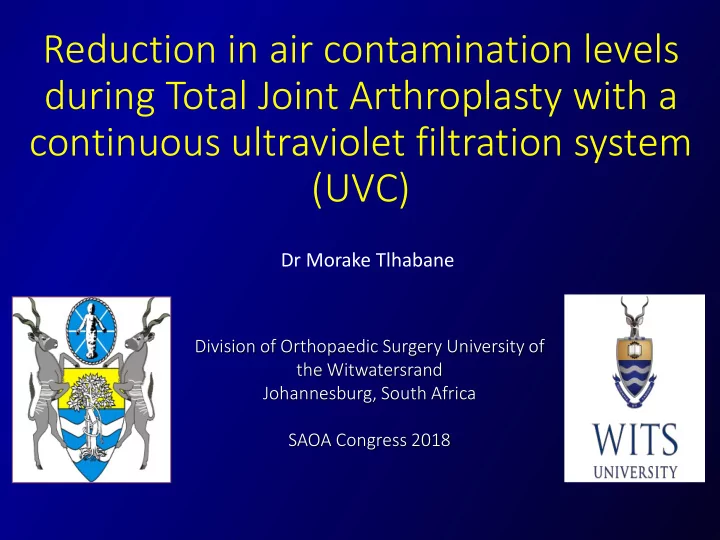

Reduction in air contamination levels during Total Joint Arthroplasty with a continuous ultraviolet filtration system (UVC) Dr Morake Tlhabane Division of Orthopaedic Surgery University of the Witwatersrand Johannesburg, South Africa SAOA Congress 2018
Aim 1. To determine how clean the air in our two orthopaedic operating theatres at Charlotte Maxeke Johannesburg Academic Hospital (CMJAH) is. 2. To determine if the addition of a HEPA Ultraviolet Air Recirculation System (HUAIRS) will improve the quality of the air in our two theatres.
Supporting Literature • Environment of care: Is it time to reassess microbial contamination of the operating room air as a risk factor for surgical site infection in total joint arthroplasty? Parvizi et al AJIC 2017 • Reduction of Particles in the Operating Room Using Ultra Violet Air Disinfection and Recirculation Units. Higuera et al The Journal of Arthroplasty 2017 • The Effect of a Novel Air Decontamination-Recirculation System on Viable Airborne Particulates. Walsh, w The European Bone and Joint Infection Society 2017 • HUAIRS Outcome Study: Atlanta SSI Reduction Results. The Healthcare Environment Institute 2015 • Reduced prosthetic joint infection rates with use of intraoperative air decontamination: A retrospective cohort study. Cook, HEI 2002 • The International Consensus Meeting on Musculoskeletal Infection July 2018
How does HUAIRS work? • Step 1 utilises a disposable performance cartridge that removes large contaminants and debris. • Step 2 utilises a solid medium that prolongs the exposure time of suspended pathogens and is continuously irradiated with germicidal radiation of 254nm wavelength (UVC). • Step 3 utilises a cleanroom-grade HEPA filter (99.97% rated) to capture residuals.
Materials • The following equipment was Used to determine if a HUAIRS can improve the quality of operating theatre air: • Aerobiotix Illuvia 500UV Professional Air Treatment System
Materials • Aerotrak Handheld Particle Counter Model 9303
Methods • Air particles were measured at five different locations around the theatre, without the HUAIRS running, every two minutes using the handheld air particle counter, during TJA procedures. • The measurements were repeated with the HUAIRS running for at least 30 minutes. • The baseline counts were compared to the HUAIRS counts, and the reduction was measured for each location during every evaluation. • In total, measurements were done during the following 31 procedures: • 11 primary THRs and 3 revisions • 13 primary TKRs and 4 revisions • In 6 evaluation both counts were done in only one theatre, and in 18 evaluations counts were compared between two theatres.
Theatre Diagram
Results for the 1,0µm particle counts • Control 134 000 particles/m³, HUAIRS 52 792 particles/m³ (average). This is a 60,6% reduction with the HUAIRS running, p=0,0037.
Results for the 5,0µm particle counts • Control 14 917 particles/m³, HUAIRS 7 208 particles/m³ (average). This is a 51,7% reduction with the HUAIRS running, p=0,0012.
Results • The air quality in the theatres was initially very good because of laminar air flow, good infection prevention protocols and staff compliance. • However, despite this, the HUAIRS still managed to reduce the 1,0µm and 5,0µm particles by over 50%, and these are the particles that transport pathogens through the air. • Spikes in the particle counts were attributed to high levels of cautery smoke due to use of diathermy, and door openings (0,79 times per minute). • The HUAIRS was left in the same position for all evaluations, but the unit can be positioned almost anywhere in the room.
Conclusions • The data shows a reduction in airborne contamination of 56,1% for the different particle sizes that were measured. • The HUAIRS improved the quality of air in the operating theatre. • Further studies are required to determine if the reduction in air particles leads to a reduction in PJI.
Recommend
More recommend